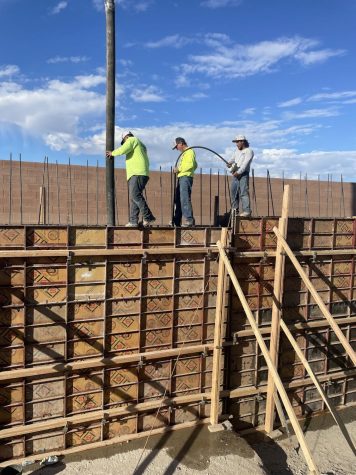Rehearse..Ice Feet..Repeat..
May 10, 2018
dance
/dans/
Verb
A physically and mentally demanding activity that includes the movement of the body synchronized to music that requires strength, passion, discipline, and dedication.
From the grueling training process in the studio to the encore-worthy performances on stage, the life of a dancer is not as easy as it seems.


Dancers are often underestimated and don’t receive as much credit as they deserve; however, dance takes just as much time, dedication, and strength as any other sport. But not only is it a sport, dance is a form of art and self-expression.
The reality of dance is something that many don’t understand. Dancers are some of the most highly stereotyped people, and it all starts when someone new discovers one of their peers is a dancer.
“Are you like a ballerina or something? Can you do the splits? Let me see you whip!” Any dancer could agree that these are some of the most typical responses they get when someone new finds out they dance.
This is because many people assume that all dancers do the same thing, which they don’t. The hardest part about having a conversation with someone who stereotypes dancers is wanting to educate them with a slide show and a 10 page essay about how ballet is not just “standing on your tippy toes.”
Furthermore, dance is not limited to leotards and ballet shoes and all those offensive dance challenge videos on social media.
Dance is extensive amounts of classes and rehearsals where choreography and technique is practiced and perfected. These training sessions are hours upon hours of difficult work, all just for 2 minutes on a stage; this is something that nobody understands unless they’ve done it themself.
Dancers are some of the most passionate and dedicated people you will ever meet. Most dancers are full time, so they can’t do anything else besides dance. This is because it is extremely difficult to master the precision and technique of dance without training every single day.
All of the dance moms and dads can agree that from the cost of shoes, practicewear, costumes, lessons, intensives, and competitions, dance is one of the most expensive things you could ever put your kid through. According to FiveThirtyEight, raising a highly trained ballerina from the age of 3 until the time he or she turns 18, can put you out more than $100,000.
Whether it’s a challenging routine with little time to practice, a difficult audition, or a struggle with confidence, dancers are under extreme pressure almost always.
Body image issues and eating disorders are a huge problem in the dance industry. They all feel as if they need to maintain the “ideal” dancer’s body as well as look up to standard in their costumes.
Since dancers spend the majority of their time staring at themselves in the studio mirrors, it’s easy for them to begin comparing or judging themselves. Striving for perfection always seems to be the main goal.
This is what causes fellow dancers to become so close; they understand one another and can relate to the pressure they go through daily. Dance is highly competitive, but at the end of the day, dancers are all each other’s biggest fans.
Dance schedules are almost overwhelming, especially for those who are teachers/leaders, or a part of multiple productions. For the most part, the dance season is year round and never ends.
Not only is it time consuming, dance has a high physical demand in terms of flexibility, coordination, agility, stamina, and much more. No dancer has ever become successful riding on their natural talents alone, it takes discipline with a strong body and mindset to get to the top.
Although now it seems to be all work and no play, that is not the case. Dancers travel very often, especially those who don’t live in big cities where most events are held, like competitions and conventions.
Dance competitions are unlike any other sporting event or contest for many reasons. For example, football or basketball players have 4 quarters to score as many points as they can; however, dancers have only 2 minutes. In any other sport, if you fall there’s always another chance to redeem yourself or get more points.
Dance competitions aren’t like this at all: there’s only one performance and one chance to prove yourself. Plus, the fate of whoever wins is in the hands of a panel of judges, not just the team itself.
Whether it’s a master class with a famous choreographer, or the chance to audition for a big production, dance is constant opportunity. With the right training and guidance, dancers can take their skills and turn it into a lifelong career, which many people don’t realize can happen.
There is a wide range of jobs or careers for dancers that normal people don’t recognize, such as dance teacher, choreographer, company or theatre administrator, costume designer, manager, and many more.
From concerts and music videos to Broadway shows, dancers have a huge role in the professional entertainment world. You can almost always spot dancers on stage with your favorite singer, or even on a TV show.
The most magical part about dance is being able to tell a story without saying a word. Dance can turn the most difficult situations into something beautiful. Some of the most talented choreographers are able to take a dark topic and express it through movement.
Whether they’re competitive, studio, entertainment, or professional, every dancer is an artistic athlete with a strong passion for what they do. For hundreds of thousands of aspiring artists, dance is everything they live and breathe for. It is not just learning movement, but a way of life.

















